Dudley P. Flanders
"Trip Through Arizona" December 1873 - November 1874
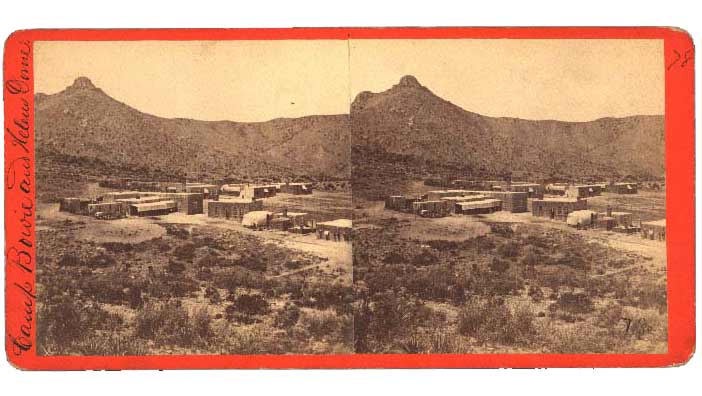
|
|
Overview
of Fort Bowie, Arizona Territory at the base of Helens Dome, taken in
Late July or early August 1874. Fort Bowie was established in 1862 to
protect travelers as they crossed through Apache lands in Southern Arizona.
Image number 75 on orange D. P. Flanders Photographic Album of Trip
Through Arizona mount. Collection of the Author. Copyright 2000
Jeremy Rowe, All Rights Reserved.
|
Arizona was an obscure, little known
corner of the country prior to 1870. The best known landmarks were probably
Maricopa Wells, the last water on the Butterfield Stage route before the Colorado
River on the way to California, and the river crossing at Fort Yuma.
1871 saw national attention begin
to focus on Arizona as photographs from the Wheeler and Powell surveys showed
the country the natural wonders of the Grand Canyon. As awareness of Arizona
began to grow, entrepreneurial photographers began seeking images to feed interest
in images of the West. One of the first photographers who sought to capitalize
on the interest in Arizona was Dudley P. Flanders. Born in Massachusetts in
1840, by 1865 Flanders had settled California, marrying Miss Olivia Armstrong
in Eureka California on December 31 of that year. In early March of 1866 Flanders
purchased W. N. Tuttle's interest in the Eureka Photographic Gallery, and soon
advertised the availability of ambrotypes and card photographs. Business apparently
was far from brisk, and the gallery was closed on July 11th. Flanders stayed
in the Humbolt county area through the end of the year.
Flanders surfaces in San Francisco
briefly in early 1867, and reappears later in the year in Grass Valley, Nevada
operating the Premium Photographic Gallery in partnership with a Mr. Vance.
This photographic business was apparently successful, as Flanders opened a branch
gallery in Truckee, California, advertising in the Truckee Tribune on October
31, 1868
By 1873, Flanders had moved once
again, to Los Angeles operating the Art Photographic Parlor in Downey's Block
on Main Street under the partnership of Flanders & Godfrey. The Gallery
offered large and stereoscopic views of Los Angeles, San Bernadino, and San
Diego counties.
Beginning in 1871, the federally
funded Wheeler and Powell survey expeditions to the Grand Canyon began to raise
public interest awareness of the Arizona Territory. Photography played a key
role in the promotion of the expeditions and of the relatively unknown Southwestern
U.S. One of the key media used to promote the expeditions was the stereograph.
Stereographs used the principle
of binocular vision to permit the viewer to perceive three dimensional depth
from two, two dimensional images. Human eyes are separated just over two
inches, giving each eye a slightly different perspective for its view
of the world. When two photographs are made from similarly separated perspectives,
and are viewed in a manner in which the left eye sees only the let eye perspective,
and the right eye sees only the right perspective, the viewer perceives a single,
three dimensional image. Stereographs were one of the most popular mass media
of the 19th century, and stereographs of Native Americans and the fauna, flora,
and geologic formations of the Southwest were popular subjects collected worldwide.
The stereo process typically used
a small negative size, yielding a relatively short exposure time. Both factors
made stereo an ideal format for location photography in the days of wet-plate
photography where photographers had to coat, expose, and process the negative
before the colloidion surface dried. The stereograph was produced by contact
printing the negative, then trimming, aligning, and mounting the two photographic
images on a card mount.

|
|
Pack
train for excursion from Tucson to San Carlos, Reservation. This image
shows the photographic party including Dudley Flanders and Adolpho Rodrigo
at the San Carlos Reservation. Taken in in September or October 1874.
Image number 78 on yellow Scenes in Arizona, D. P. Flanders Artist
mount. Collection of the Author. Copyright 2000 Jeremy Rowe, All Rights
Reserved
|
Most stereographs marketed prior
to the mid 1880s were produced as albumen prints mounted on card stock.
Typical mount sizes were 7" wide and 3 1/2" high holding 2 - 3 X 3 1/2"
prints. Later, larger mounts 4", 4 1/2" and 5" high became
popular, each maintaining the standard 7" width. The images of Arizona produced
by Flanders appear in both the small and large stereo mount sizes. Production
and distribution of stereographs was an economic foundation for many photographers,
and the competition for images of timely subjects was fierce, both in creating
original images, and occasionally in creating "pirated"copy views
of popular images.
Late in 1873, Flanders decided to
travel to Arizona to capitalize on the national interest generated by the stereographs
made by the pioneer survey photographers such as E. O. Beaman, John Hillers,
and Timothy O'Sullivan. On November 13, Flanders initiated a partnership with
Henri Penlon for an excursion East into Arizona to make and market stereographs
of the emerging Arizona Territory.
The two entrepreneurs left Los Angeles
on November 14, arriving at Ft. Mohave, Arizona Territory on December 8, then
traveling on to the capital of the Territory, arriving in Prescott on
December 21. Flanders & Penlon took stereographs of the stage stops and
forts that marked their travel across Arizona. The December 26 edition of the
Prescott Miner carried an advertisement for the two photographers, offering
views of Fort Mohave, Camp Beale Springs, and other locations on the route from
California.
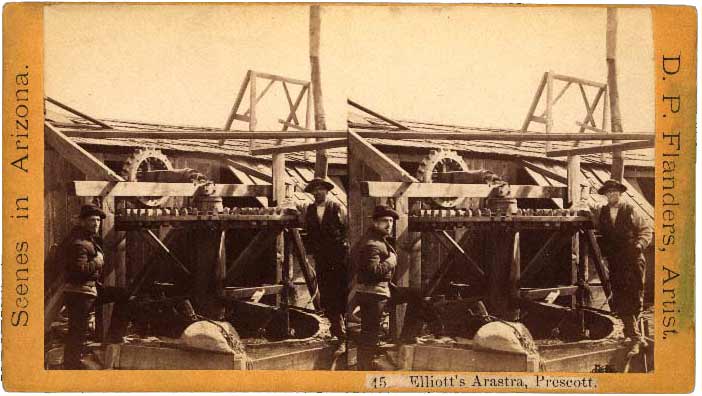
|
|
Detail
view of Elliott's Arastra, a primitive mechanical device for crushing
ore as part of refining. Elliott also apparently offered a metal fabrication
service for local miners. Taken near Prescott, A. T. in Spring
, 1874. Image number 45 on yellow Scenes in Arizona, D. P. Flanders
Artist mount. Collection of the Author. Copyright 2000 Jeremy Rowe,
All Rights Reserved.
|
During the first month of 1874, Flanders and Penlon worked in central Arizona,
making views of the Prescott area and traveling South East to the Fort Verde reservation.
While in Prescott, the partners operated out of the first photographic studio
operated in Arizona, then owned by F. A. Cook. The advertisement from the
January 10, 1874 Prescott Daily Miner that ran throughout the month stated:
PHOTOGRAPHIC NOTICE,
Do not forget that FLANDERS & PENLON, Artists, remain in Prescott only during
the present month. And the public are particularly requested to call and examine
specimens of work MADE IN PRESCOTT, whether they desire work or not, as it is
always a pleasure to receive visitors. Their LIFE SIZE PORTRAITS CANNOT BE EXCELLED.
Pictures taken in cloudy weather guaranteed to any taken on the brightest day.
During the travels in January, Mr.
Penlon became ill, eventually critically. Henri Penlon passed away at the home
of William Buffman on February 6. Flanders continued to honor his agreement
with Henri Penlon and retained the name of the partnership on both his advertisements
and photographic mounts throughout much of his stay in Arizona.

|
|
Tonto
Apache scout and his family , probably taken near Camp Verde in Central
Arizona, showing a typical Tonto Apache dwelling in the background
Taken in Spring 1874. Image number 100 on yellow Scenes in Arizona,
D. P. Flanders Artist mount. Collection of the Author. Copyright
2000 Jeremy Rowe, All Rights Reserved.
|
Flanders remained in Prescott through
April of 1874 and continued to make stereographs of the area. An advertisement
in the Arizona Miner on April 3 offered: Stereopticon views of the Aztec ruins
on Beaver Creek, views of the Verde Valley, Fort Whipple, Prescott in Winter,
Prescott in Summer, Mr. Prescott, the Indian agency with its 1500 savage Apache,
who stand, sit, and lie for the operator and his masked battery.
Prior to leaving Prescott, Flanders
offered a 5 day series of lectures illustrated with the images made in Arizona
to that date. The lectures were illustrated by a projection system called a
"stereopticon"which projected slides, often made from half of the
stereo negative. The presentations were well received and received a positive
review in the Arizona Miner on April 24.
By invitation , we
visited Mr. Flanders' stereopticon presentation rehearsal last evening and were
positively gratified at what we saw. His foreign views are simply splendid,
and the views of camps and Indians here in the Territory are all that could
be wished. We would suggest this entertainment as instructive and, we believe,
will prove more than the money's worth to anyone who may choose to attend. His
performance will continue for 4 evenings. Mr. Scott assistant to Mr. Flanders,
is an excellent hand in this line of business, and has done much credit to himself
in the part he has performed in the preparation of these views.
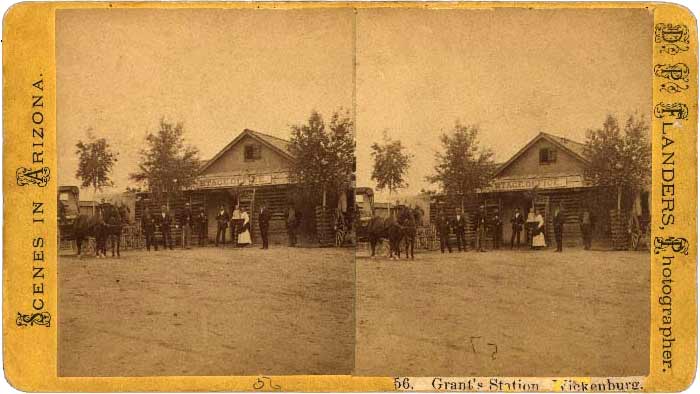
|
|
The
traveling party posed in front of Grant's Station, the stage
coach office in Wickenburg, A. T. Wickenburg was established to supply
the Vulture Mine in central Arizona. National attention focused on
the area when Henry Loring of the Wheeler expedition was murdered
by Indians outside of Wickenburg in 1871. Taken in Spring 1874. Image
number 56 on yellow Scenes in Arizona, D. P. Flanders Artist
mount. Collection of the Author. Copyright 2000 Jeremy Rowe, All Rights
Reserved.
|
Flanders traveled on the stage route
South through Wickenburg and Maricopa Wells to Tucson to continue his tour.
By June 6th Flanders was advertising in the Arizona Citizen offering retouched
negatives, cabinet photographs, and frames in addition to his stereographs of
Arizona. Building on the success of the stereopticon lectures in Prescott, Flanders
advertised lectures at Levin's Garden in Tucson on June 13.
Soon after his arrival in Tucson,
Flanders began working with a local itinerant photographer, Adolpho Rodrigo,
who operated the city's major studio. Images made at this studio exhibit significant
problem with processing resulting in significant fading and discoloration. This
problem appears to relate to the studio, as the condition problems are shared
with at least one other photographer who subsequently used the studio, Henry
Buehman.
Southeastern Arizona was known as
rough and dangerous territory, and there was great public interest in views
from this area. To add images of this area to his portfolio, Flanders began
a trip to Fort Bowie and New Camp Grant on July 11th. Fort Bowie had been established
for almost 14 years, and had been the focus of action with Cochise. Camp Grant
had recently moved to a more pleasant location and the popular press was full
of reports of the attempts to control Arizona's hostile Apache along the stage
routs and among the mining camps and towns beginning to grow throughout the
Territory.

|
|
"School
portrait"of the Clergy and Papago constituents at the Indian School
at San Xavier Mission south of Tucson, taken in Late July or early August
1874. Image number 68 on orange D. P. Flanders' Photographic
Album of Trip Through Arizona mount. Collection of the Author. Copyright
2000 Jeremy Rowe, All Rights Reserved.
|
Upon his return to Tucson on August
8th, Flanders worked out of the studio of Adolpho Rodrigo. Rodrigo had arrived
in Tucson and opened a studio on the corner of Courthouse and Maiden Lane late
in July.
In an ad in the August 22nd Arizona
Citizen, Flanders gave notice that he would soon be departing Tucson. Flanders
and Rodrigo, apparently working together, left Tucson for the San Carlos reservation
and Fort Apache. The gallery in Tucson was left "open and in charge of a competent
artist" (who is as yet unidentified) during their trip.
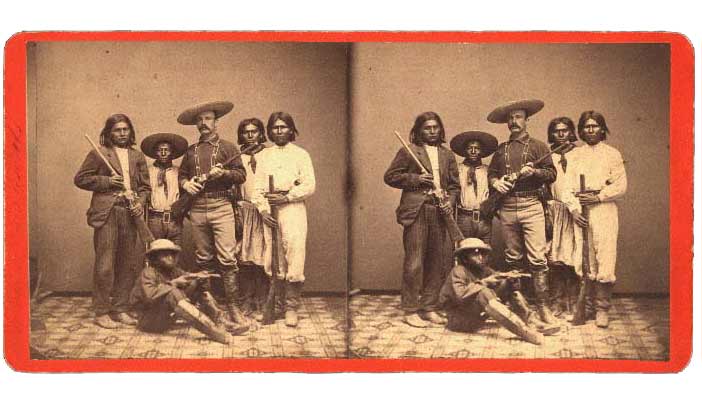
|
|
Studio
portrait of Apache agent John Clum with his scouts taken a few days
after his arrival at the San Carlos Reservation. John Clum was an extremely
successful Indian Agent and a major figure in the development of Arizona
as publisher of the Tombstone Epitaph. Clum also was known for his contributions
as the Postmaster for the State of Alaska. Taken in early August 1874.
Image is unnumbered, on orange D. P. Flanders Photographic Album
of Trip Through Arizona mount. Collection of the Author. Copyright
2000 Jeremy Rowe, All Rights Reserved.
|
While at San Carlos, Flanders and
Rodrigo concentrated on the notables that they found. The images from this period
include studio portraits of General George Crook, military head of Arizona,
and the Indian Agents at San Carlos, Mr. Roberts and his newly arrived replacement
John Clum. The reservation provided an ideal opportunity to document life on
the reservation, and to make portraits of the Apache chiefs key to the existence
of the reservation such as Diablo, and Casadora.
After a month and a half on the
road Flanders and Rodrigo returned to Tucson on October 24th. Flanders left
to return to California by stage on October 29th. The last notice of Flanders
activity in Arizona is his listing as a passenger on the steamer the Jolly Giant
leaving Yuma up the Colorado on November 25th.
After his return to Los Angeles,
Flanders began marketing the stereographs under the series title Scenes in Arizona.
Flanders offered the stereographs from the Arizona trip on three mounts, the
earliest was an orange and purple mounts labeled " A Photographic Album of a
Trip Through Arizona by Flanders and Penlon".Many of these views were probably
printed in Arizona at either the Prescott or Tucson studio where Flanders worked.
Later, probably after his return to Los Angeles, Flanders offered the
views with printed labels on yellow mounts with two versions of the "Scenes
in Arizona" series title, one with the title in a plain letter form, the other
using a more elaborate script.

|
|
Outdoor
studio portrait of Apache Chief Hosea, at the San Carlos Reservation
in Southern Arizona. Hosea was a scout and is shown well armed with
his rifle, pistol and bowie knife. Taken in late July or early August
1874. Image number 78. On yellow Scenes in Arizona, D. P. Flanders
Artist mount. Collection of the Author. Copyright 2000 Jeremy Rowe,
All Rights Reserved.
|
In research to date, over half of
the titles offered by Flanders have been identified on one or more of the mounts.
It is interesting to note that the sequence of images roughly follows the path
of the Flanders excursion through Arizona. Also, images from this series have
been identified on the mounts of several photographers and publishers including
Payne, Stanton, & Co. of Los Angeles, Williscraft of Prescott, and the Continent
Publishing Company. Whether these appearances are examples of pirating or were
legitimate uses of the images is not known.
The body of work produced by Dudley
Flanders offers one of the best views of life in Territorial Arizona in the
mid-1870's that has been identified to date. Unfortunately, with the exception
of a few images, they have remained virtually unknown during the 120 years since
they were produced. Flanders work provides a much more personal, intimate and
realistic view of life in Territorial Arizona than most of the work produced
by the expedition photographers whose images have become icons of the 19th century
West.
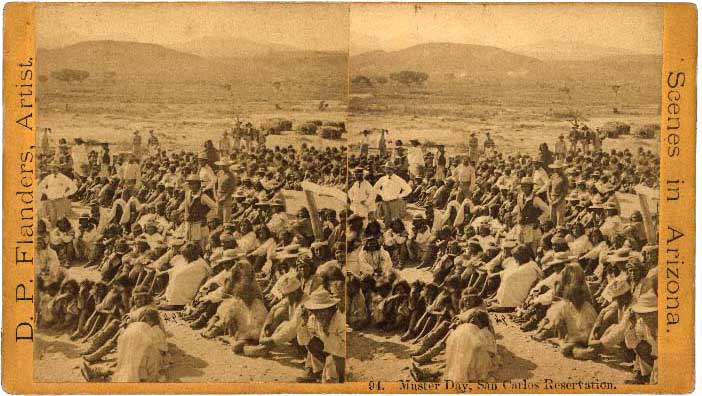
|
|
Distribution
of rations, Muster day, at the San Carlos Reservation. Tribes
represented were Mohave, Yuma, and Apache bands including Arivaioa,
Chiricahua, Coyoterto, Mimbreno, Mogollon, Pinaleno, San Carlos, Tonto,
and Tsiiladen. Taken in September or October 1874. Image number 94
on yellow Scenes in Arizona, D. P. Flanders Artist mount. Collection
of the Author. Copyright 2000 Jeremy Rowe, All Rights Reserved.
|
Master list of Stereograph Titles
by Dudley P. Flanders
Notes: Titles were taken from both
printed and manuscript notations on the mounts of stereographs by Dudley P. Flanders
and his associates. Spellings are per the original. Duplication of numbers with
alternate titles in different series occurs in several cases as noted. Images
marked "manuscript"titles are on Orange Flanders & Penlon and D.
P. Flanders mounts and reflect a secondary numbering system, probably earlier
from the Arizona publication. Other titles are from printed labels, probably printed
after Flanders returned to Los Angeles. Unnumbered titles appear alphabetically
at the end of the listing. Documented additions to this list are greatly appreciated.
1. Atkinsons Station, Mohave
River
2. Cottonwood Station, Mohave
River
2. Scene near Soda Lake, Ca.
3. Soda Lake (alt. title)
4. Cave Station, Mojave River
4. Camp Beales Springs, A.T.,
Looking S. (alt. title)
6. Camp Mojave A. T. Looking
down teh river - 1873
7. Camp Mojave, A.T.
9. Camp Beales Springs, Arizona,
Dr. Reagles Quarters
10. Hualpai Mtns. as seen from
the Cerbat Range
12. Indians at Camp Beale Springs
13. Camp Beale Springs
13. Montezuma Wells, N. Side.
(alt. title)
15. Prescott in Summer
16. Prescott in Winter
17. Arizona Prospectors
17. Prescott in Summer (Gurley
at Montezuma Street) (alt. title)
19. Beaver Creek
19. Montezuma Wells, South Side
(alt. title)
19. Genl Crooks Band (alt. title)
20. Apache, Tonto (portrait
of 3 indian maidens and a child)
20. Arizona Prospector (alt.
title)
20. Montezuma Wells (alt. title)
21. Montezuma Wells, East Side
(manuscript title)
24. Reservation Peak at Verde
Reservation
26. Ruins at Montezuma Wells
(manuscript title)
27. Apache Tontos' Wickeups
29. Yuma Apaches Wickeups
31. Muster Day at Verde Reservation
32. Chiefs at Verde Reservation
(manuscript title)
32. Squaws at Verde Reservation
(alt. title)
33. Apache Chiefs Mounted, at
Verde Reservation
34. Squaws at Reservation
36. Mohave-Apache Wicker-ups
38. Birds eye view Verde Valley
40. Aztec Ruins, Opposite Camp
Verde
42. Montezuma Caves on Bear
Creek
44. Elliotts Factory, Prescott
45. Elliotts Arastra, Prescott
47. Unidentified river scene
51. Ft. Whipple Looking N.
51. Telegraph Station at Maricopa
Wells (alt. title)
52. Moores Station, at Maricopa
Wells
52. Reservoir Hill North of
Fort Whipple, Prescott, Az.
55. Ft. Whipple (looking toward
San Francisco Mtns)
56. Grants Station, Wickenburg
58. Station on the Hassayampa
60. Mouth of the Hassayampa
61. Grants Station, Wickenberg
(handwritten)
62. Grants Station, Gen'l view.
James Grant's Stage Station,Wickenberg, Arizona.
62. Moore╠s Station, at Maricopa
Wells (alt title)
65. Papajo Reservation from
Tower of S.X.C.
66. Papajo Reservation from
Tower of S.X.C.
67. Papajo Reservation from
San X. Church
68. Papajo School, San Xavier
69. Crossing of the San Pedro
69. Indian Agency, Pima Reservation
(manuscript title)
70. Camp Bowie (Apache Pass)
- Looking S.
70. Corpus Christi, Tucson (manuscript
title)
71. Church of San Xavier. San
Xavier Del Bac.
71. San Xavier Church (manuscript
title)
72. Papago vil. - near San Xavier
72. Old Camp Bowie (Apache Pass.)
73. View of Papago Village (manuscript
title)
74. Helens Dome, Apache Pass.
74. View of Papago Village (manuscript
title)
75. Camp Bowie (Apache Pass)
Looking South
75. Papago School at San Xavier
(manuscript tile)
76. Group of Officers and Ladies,
Apache Pass
77. Upper Crossing, San Pedro
(manuscript title)
78. Hosea, Apache Chief (seated
studio portrait of Zeli Chiracahua chief)
78. Camp Bowie and Helen╠s Dome
(manuscript title)
79. Es-kim-en-zin. a Renegade
Chief
79. Camp Bowie, looking S. E.
(manuscript title)
80. Es-kim-en-zin & band,
prisoners, Camp Grant
80. View of Old Camp Bowie &
¤Pass (manuscript title)
81. Guard-house, Camp Grant
81. View of San Sinon Valleythru╠
Pass (manuscript title)
82. View of Mt. Graham from
Camp Grant
82. Helens Dome, Apache Pass
(manuscript title)
83. Headquarters at Camp Grant
83. Group of Officers &
Ladies, Camp Bowie (manuscript title)
84. Goodwine Canon, Apache
Pass (manuscript title)
85. Camp Bowie looking South
(manuscript title)
85. Indian Prisoners, with implements
of peace (alt. title)
88. San Carlos Indian Reservation
89. Guard House, Camp Grant
& Mount Graham (manuscript title)
90. Casadora and Wives, Chief
at San Carlos
90. Mt. Graham from Camp
Grant (manuscript title)
91. Headquarters, Camp Grant
(manuscript title)
91. Squaws at San Carlos Reservation
(alt. title)
92. Headquarters with Canon,
Camp Grant (manuscript title)
92. Indian Girls at San Carlos
Reservation (alt. title)
93. Agent and Chiefs, San
Carlos Reservation
94. Muster Day, at San Carlos
95. Pack Train, San Carlos Reservation
96. Apache Boy Es-Kin, San Carlos
Reservation
97. Counting Apaches at Camp Apache
98. Apache Scouts at Camp Apache
(Cooley, Lt. Rice, Genl. Crook, Maj. Randall, Lt. Reilly, McGill,
Es-Ki Elaw, Peboni )
99. View of Tucson, A. T. (manuscript
title)
100. Tonto Apaches
102. Apache Tonto (3 young
women and child in front of dwelling)
Un-numbered Vews
Beale Springs, Arizona (manuscript
title on reverse)
Colorado River near Mojave,
A.T.
Five San Carlos Apache Indians
and [name illegible]-Camp at night on a trail
Genl Crooks Band (at the new
courthouse, Prescott)
John Clum and his Apache Scouts
Montezuma Wells, East Side
Montezuma
Unidentified scene of Camp
Grant (similar to 82)
View at Camp Apache, A.T.








